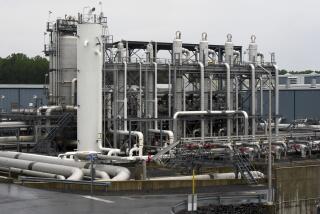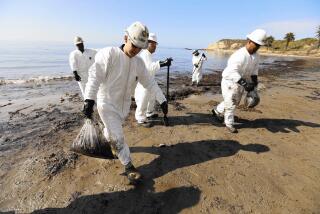Nebraska regulators approve Keystone XL pipeline after years of controversy
Following years of political controversy that demanded the attention of two presidents, the Nebraska Public Service Commission on Monday declared that the proposed Keystone XL pipeline was in the public interest but the 275-mile route it approved through the state was not the one preferred by TransCanada, the pipeline developer.
By a vote of 3 to 2, the five-member commission cleared the final regulatory hurdle for the proposed 1,179-mile pipeline from Hardisty, Canada, to Steele City, Neb., adding to routes already approved by Montana and South Dakota. President Trump overturned President Obama’s earlier rejection of the pipeline, and in March approved the federal permit for it to cross the U.S. border.
Despite a long series of delays and a slump in world oil prices, TransCanada this month expressed confidence that the $8-billion project will be able to move forward. Yet Monday’s action endorsing an alternative route may have made the path to success more difficult.
The pipeline company told the Nebraska commission this year that the route approved Monday was much more problematic than the one the firm preferred. The company will need to secure land from more farmers, a process that has already proved difficult. Of the 275 landowners the company needed for its preferred route, 100 have refused to sign leases for the Keystone XL pathway.
The new route is but one of many dimensions of the pipeline’s business plan that are markedly different from the one TransCanada wrote nine years ago when it introduced the Keystone XL project.
Oil prices are less than half what they were a decade ago. Tar sands production in Canada has leveled off. And legal challenges remain formidable: Opponents have vowed to appeal the commission’s decision and battle additional eminent domain procedures to secure new right-of-way. The legal processes for both strategies could make the Keystone XL battle an issue in the 2020 presidential election.
Russ Girling, TransCanada’s chief executive, said he is confident about the pipeline’s prospects. During a third-quarter conference call with investors this month, Girling said the company needs to secure commitments to transport 500,000 barrels of oil a day to start construction. TransCanada, he said, is close to reaching that goal.
“Overall, we expect support for the project to be substantially similar to that which existed when we first applied for the Keystone pipeline permit,” Girling said. “To be clear, production of Canadian heavy oil continues to grow, and the need for new pipeline transportation capacity remains high.”
The pipeline’s opponents vowed to carry on. “It’s not over. We will appeal,” said Jane Kleeb, the founder and president of Bold Nebraska, the activist group leading the opposition to the Keystone XL project. “There will be lawsuits to fight TransCanada’s eminent domain claims. It could be another two years before this is decided.”
Suncor Energy and Cenovus Energy, two of the biggest tar sands oil producers, have said they are committed to long-term Keystone XL transport contracts, a promising signal that Keystone XL ultimately will succeed, according to some financial analysts.
Other authorities note, though, that oil production in northern Alberta, the pipeline’s source, has leveled off at 2.5 million barrels per day as prices have plummeted from historic highs a decade ago. TransCanada’s competitors have proposed other tar sands pipelines. Banks and international financiers, moreover, are withdrawing from potential capital markets to pay for other multibillion-dollar fossil fuel projects. And the cost of construction and civic opposition to massive fossil fuel infrastructure projects has increased.
A number of analysts predict that even with the Nebraska go-ahead, the pipeline will not be built.
“There is no economic rationale, no validity to the investment calculation, no positive bottom line,” said Tom Sanzillo, director of finance for the Institute for Energy Economics and Financial Analysis, a Cleveland-based think tank, and former deputy controller responsible for managing New York’s $168-billion retirement fund. “Our view is that TransCanada is unlikely to build it.”
The Keystone XL pipeline was supposed to be the final phase of a 3,863-mile oil transport system designed to move 1.4 million barrels of oil daily from northern Alberta to refineries in Illinois and Texas, and to a mammoth storage terminal in Oklahoma. TransCanada marketed the $15-billion Keystone project as a signature piece of mega-industrial infrastructure vital to serving the sand and shale fossil fuel boom that erupted in North America around 2008.
The initial $5-billion, 1,853-mile Keystone pipeline, Keystone XL’s older sister, was permitted without conflict by President George W. Bush in 2008 and began moving oil in 2010. The Keystone XL was meant to transport 830,000 additional barrels of oil daily from Alberta.
When TransCanada introduced the project in 2008, two factors appeared to assure its economic viability: Oil prices had soared past $100 a barrel; and $10 billion in annual investment in tar sands mining and processing equipment had caused tar sands oil production to start climbing by 200,000 barrels a year.
Many of the world’s largest energy companies – Exxon Mobil, Royal Dutch Shell, ConocoPhillips, and Chevron among them – bought leases in Alberta’s northern forests, which emerged as one of the largest oilfields in the world. Their refineries on the U.S. Gulf Coast were eager for the fuel. The path from Canada through the Great Plains seemed cleared by the existing Keystone line.
The company did not anticipate the political and market turmoil around fossil fuels that quickly unfolded in the United States and around the world. Within two years of its introduction, opponents in Nebraska and across the U.S. turned the Keystone XL into one of the most visible global symbols of climate change risks and pipeline safety. Also, new technologies coming on the market were pivoting nations away from fossil fuels and toward less polluting alternatives.
Climate activists seized on the Keystone XL as a source of huge new carbon emissions from tar sands oil, which scientists identified as much dirtier than conventional oil, and widespread protests convinced Obama to reject TransCanada’s international permit to build the pipeline in early November 2015.
In Nebraska, opponents focused on a foreign company they felt was bullying the state, and the risks of an oil spill to the Ogallala Aquifer, which supplies much of Nebraska’s water. Their concerns were not unfounded: On Friday, the Keystone line, which is similar in design to the Keystone XL, leaked and poured 210,000 gallons of tar sands oil onto a South Dakota field. It was one of the largest inland oil spills in the U.S. since July 2010, when a tar sands pipeline operated by Enbridge Inc. ruptured and spilled a million gallons into Michigan’s Kalamazoo River.
Republican politicians across the Great Plains have consistently supported the project, as have business leaders.
Opposition, though, is deep and committed. Most of the 500,000 comments the Nebraska commission received expressed opposition to Keystone XL.
Similar pipeline opposition campaigns also developed in other states to spotlight spills, leaks, ruptures, and explosions that are becoming more numerous, dangerous and costly, according to the Pipeline and Hazardous Materials Safety Administration, a unit of the Department of Transportation. Since 2010, the federal safety agency has documented 4,398 serious pipeline incidents that killed 107 people and caused $3.8 billion in damages.
A national pipeline protest movement has developed. Over the weekend, 300 pipeline opponents from more than 30 states and Washington, D.C., attended the People vs. Oil and Gas Summit, an organizing conference in Pittsburgh.
“There are a ton of groups that have formed to fight pipelines, in the West and Midwest, the South, up and down the East Coast,” said David Turnbull, the director of Strategic Communications for Oil Change International, a research and advocacy group based in Washington, D.C. “In Nebraska, what we found is that there is no need for a new pipeline coming out of Canada. There is existing capacity and not much more production.”
The decline in oil prices has also affected production — and presumably, the need for new pipelines. In the last year, according to Alberta figures, more than 2.6 million acres of tar sands leases have been abandoned. ExxonMobil, ConocoPhillips, Royal Dutch Shell, BP, Chevron, and Norway’s Statoil have either sold or written down their tar sands investments.
Oil production, which was expected by grow to 4 million barrels a day by 2024, reached 2.4 million barrels a day last year and is projected to stay at roughly the same level this year. The new oil that Keystone was projected to move from Canada to the U.S. is not likely to be produced anytime soon, if at all, say analysts.
Those kinds of numbers are likely to make financing the project difficult. Major banks and international funds are withdrawing from fossil fuel investments. The $1 trillion Norwegian Sovereign Wealth Fund, one of the largest pools of investment capital in the world, last week downgraded its oil and gas portfolio and announced it was retreating from the fossil fuel market.
Another hurdle for TransCanada is a lawsuit in Montana filed by environmental groups against the Trump administration in March. The plaintiffs assert that the president violated federal environmental law by approving the Keystone XL construction permit without updating the project’s five-year-old environmental impact report. Luther Hajek, an attorney in the Natural Resources Section of the U.S. Department of Justice, told U.S. District Judge Brian Morris that the president had full authority to issue the permit, which did not require a new review. “It’s a presidential action, therefore it’s not reviewable,” said Hajek.
The government and the company filed a motion to dismiss the case, which was heard last month in Morris’ court. A ruling is expected soon.
UPDATES:
12:15 p.m.: This article was updated with additional background on the pipeline and analysis of its future prospects.
11:20 a.m.: This article was updated with reaction to the commission’s decision.
10:05 a.m.: This article was updated with additional details about the pipeline.
This article was originally published at 8:40 a.m.
More to Read
Start your day right
Sign up for Essential California for news, features and recommendations from the L.A. Times and beyond in your inbox six days a week.
You may occasionally receive promotional content from the Los Angeles Times.






